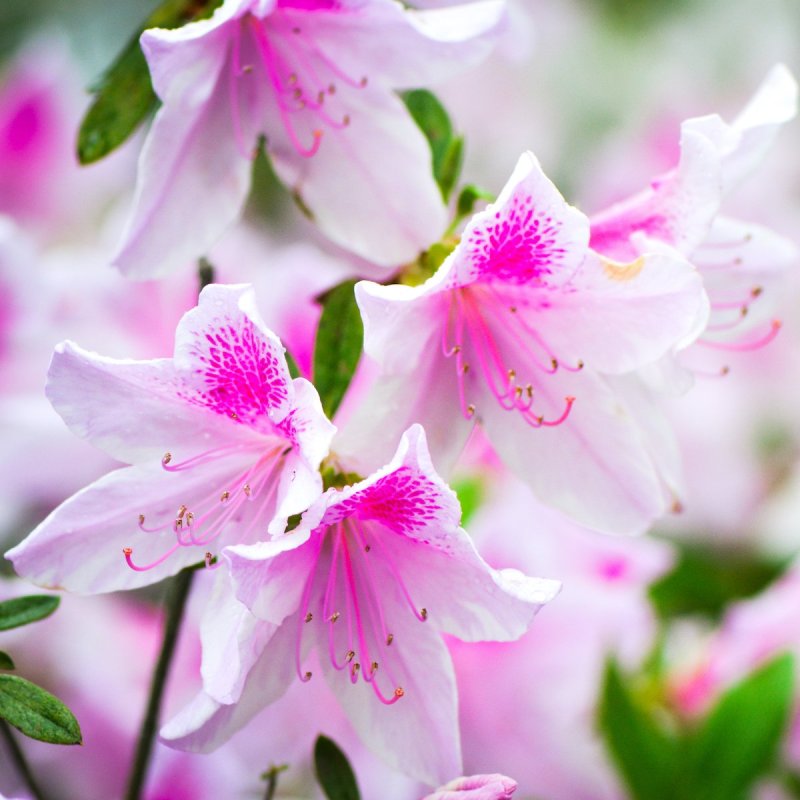
As winter drags on into the end of February in Lafayette, Louisiana, the icy chill starts to disappear and the city readies for some warmth. As temperatures rise, a profusion of color signals the start of a time-honored tradition in the city. Since the 1930s, The Historic Azalea Trail has attracted visitors who come to admire the mind-boggling blooms that line 25 miles of Lafayette’s urban core. The red, pink, white, purple, and salmon hues of the azaleas enhance historic properties, landmarks, and stately homes. It’s a sign that spring has sprung in the city, and the celebration of color and community begins.
Videos by TravelAwaits
The azalea is a flowering shrub that hails from East Asia. In Chinese, it is called “Xiang shu,” which translates to “thinking of home bush.” Two centuries ago, it was brought to the Gulf Coast and named azalea. Azalea means “dry” because azaleas love dry soil. Lafayette’s predominant variety is the Southern Indica Formosa, which bursts forth in vibrant fuchsia and lavender year after year. It was christened the “General Lafayette” in the 1950s as the city flower in honor of Marquis de Lafayette, the city’s founder. While you can view many types of azaleas during the season, including bushes around 50 years old, here are some tips to ensure you don’t miss any of the flower power and incredible offerings this spring.
1. Peak Season Is Late February Through Early March
The official bloom season runs from the last week of February through March. If you go before, you may not see the colors at their peak. For more information, check The Azalea Trail website.
2. Start At The Visitor’s Center
The best way to see all the stunning blooms is to start at the visitor’s center. Pick up a map and casually drive through the city. You can also ride a bike as the trail is flat for most of the route. The map takes you on a fascinating tour through historic districts, downtown, the University of Louisiana at Lafayette and Oil Center, and neighborhood garden districts. The tour will take around an hour, but you will make stops, take pictures, shop, grab lunch, and generally have a wonderful time. The map allows for on and off meandering.

3. Don’t Miss The Cathedral Of St. John
In 1821, Jean Mouton donated 5.4 arpents to build a chapel for the residents of Vermilionville. It was the first parish in Lafayette Parish. Over time, the chapel expanded. It was rebuilt due to the destruction caused by the Civil War and a devastating storm. With the construction of a new church in 1916, the Cathedral of St. John stood the test of time. It was bestowed with the title of Cathedral in 1918 and still stands today and is a stop on the Azalea Trail. The 500-year-old Live Oak tree on the grounds is also an essential part of Lafayette’s history.

4. Make A Detour To View Cypress Lake
While it is not one of the specific stops along the Azalea Trail, Cypress Lake is on the way and worth a short detour. It is a 2-acre natural wetland in the heart of the University of Louisiana at Lafayette campus. It is a habitat for alligators, birds, and students, who lovingly refer to it as “The Swamp.”
5. Stop At The Hilliard Art Museum
Another stop on the trail, the Hilliard Art Museum at the University of Louisiana at Lafayette has a permanent collection of 18th- through 21st-century European, Asian, and American artworks. Plus, it offers 11,000 square feet of gallery space that features changing exhibitions of regional, national, and international art. Outdoors, there are street murals to enjoy along the trail throughout downtown. To find street art, check out Downtown Lafayette’s website. Local artisan work is for sale at Sans Souci Fine Crafts Gallery.

6. Bring Your Camera
You may want to stop and shoot photos of the breathtaking floral displays. A few suggested places along the trail are the visitor’s center, Girard Park, Mouton Gardens (aka Les Jardins de Mouton), and downtown along Jefferson Street. As a bonus, when you enjoy the trail, you will observe camellias, Japanese and southern magnolias, live oaks, cypress, pines, and native plants along the way. You may also feel inclined to snap a few shots at the many historic properties around the trail. To learn more about the historic properties along the way, visit the Preserving Lafayette website. Here you can find walking tours for specific historic districts.
7. Get Lunch At Old Tyme Grocery
When hunger strikes, you have to head to Olde Tyme Grocery. They make New Orleans-style po’boys that are legendary. Voted “#1 Budget Dining in The Nation” on Tripadvisor Traveler’s Choice Awards, this no-frills dining experience is a must in Lafayette.
It’s a take-out or patio dining establishment whose busiest season begins after Ash Wednesday during Lent. On Fridays, the seafood Poor Boys fly off the shelves, including the crawfish, shrimp, oyster, and catfish varieties. If you aren’t a seafood lover, they have ham, turkey, roast beef, swiss, or two meat combos and burgers. They are open late during the week but closed on Sunday. Do not miss out.

8. Ride A Trolley
On Saturday, March 18, a trolley will take guests on a full-route of the 25-mile azalea trail with historical narration tour guides. The event begins at 9 a.m. at The Roy House. Bring a lawn chair and a picnic to enjoy out on the Grand Mall in Les Jardins de Mouton.
9. Buy Azaleas At All Seasons Nursery
After witnessing all the beauty and splendor of the azaleas in Lafayette, you might want to spruce up your own yard at home. All Seasons Nursery on Johnston Street partners with the Azalea Trail and is the go-to place to purchase azaleas.
Bonus: Explore Downtown
There is excellent shopping and dining downtown once you have had a chance to visit all the must-see sights on the azalea trail or if you want to take a break while admiring the blooms. Lafayette is known as a foodie city with great places to enjoy all kinds of cuisine. In the center of town is Moncus Park. On Saturdays, you will find a farmers market with fresh produce, food vendors, artisan crafts, and baked goods. Now that construction is complete, Moncus Park adds 100 acres of new green space to the city, enhancing its natural beauty.
Lafayette is now certified as an “Azalea City” by the Azalea Society of America, which hosted its annual convention there last spring. The city has some of the best and most authentic Cajun and Creole cuisine, culture, music, art, and shopping in Louisiana. Between the flowers and the food, no wonder it’s known as the “Happiest City in America.”
